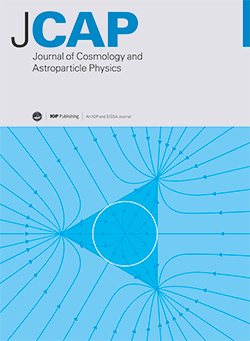Breaking parity: the case of the trispectrum from chiral scalar-tensor theories of gravity
IF 5.3
2区 物理与天体物理
Q1 ASTRONOMY & ASTROPHYSICS
Journal of Cosmology and Astroparticle Physics
Pub Date : 2025-07-16
DOI:10.1088/1475-7516/2025/07/051
引用次数: 0
Abstract
Recently, possible hints of parity violation have been observed in the connected galaxy four-point correlation function. Although the true origin of the signal from the analysis has been debated, should they have a physical origin, they might point to primordial non-Gaussianity and would be evidence of new physics. In this work, we examine the single-field slow-roll model of inflation within chiral scalar-tensor theories of modified gravity. These theories, treated here as new Lorentz-breaking theories, extend the Chern-Simons one by including parity-violating operators containing first and second derivatives of the non-minimally coupled scalar (inflaton) field. This model is capable of imprinting parity-violating signatures in late-time observables, such as the galaxy four-point correlation function. We perform an analysis of the graviton-mediated scalar trispectrum of the gauge-invariant curvature perturbation ζ(t,x) using one of the parity-violating operators of these theories as a case study. We estimate that for a set of parameters of the theory it is possible to produce a signal-to-noise ratio for the parity-violating part of the trispectrum of order one without introducing modifications to the single-field slow-roll setup. Even if the signal found in the analysis turns out to be spurious or if no parity violation is ever detected in the galaxy four-point correlation function, our analysis can be used to constrain the free parameters of these theories.破宇称:引力的手性标量张量理论的三谱
最近,在连通星系四点相关函数中观测到宇称违反的可能迹象。尽管从分析中得到的信号的真正来源一直存在争议,但如果它们有一个物理来源,它们可能指向原始非高斯性,并将成为新物理学的证据。在这项工作中,我们研究了修正引力的手性标量张量理论中的单场慢滚膨胀模型。这些理论,在这里被视为新的洛伦兹破缺理论,通过包含包含非最小耦合标量(膨胀)场的一阶和二阶导数的奇偶违反算子,扩展了chen - simons理论。该模型能够在晚时间观测中刻印奇偶违反特征,例如星系四点相关函数。我们使用这些理论的一个宇称违反算子作为案例研究,对规范不变曲率扰动ζ(t,x)的引力子介导标量三谱进行了分析。我们估计,对于理论的一组参数,有可能产生一阶三谱的奇偶违反部分的信噪比,而无需对单场慢滚设置进行修改。即使在分析中发现的信号被证明是虚假的,或者在星系四点相关函数中没有检测到宇称违反,我们的分析也可以用来约束这些理论的自由参数。
本文章由计算机程序翻译,如有差异,请以英文原文为准。
求助全文
约1分钟内获得全文
求助全文
来源期刊

Journal of Cosmology and Astroparticle Physics
地学天文-天文与天体物理
CiteScore
10.20
自引率
23.40%
发文量
632
审稿时长
1 months
期刊介绍:
Journal of Cosmology and Astroparticle Physics (JCAP) encompasses theoretical, observational and experimental areas as well as computation and simulation. The journal covers the latest developments in the theory of all fundamental interactions and their cosmological implications (e.g. M-theory and cosmology, brane cosmology). JCAP''s coverage also includes topics such as formation, dynamics and clustering of galaxies, pre-galactic star formation, x-ray astronomy, radio astronomy, gravitational lensing, active galactic nuclei, intergalactic and interstellar matter.
 求助内容:
求助内容: 应助结果提醒方式:
应助结果提醒方式:


